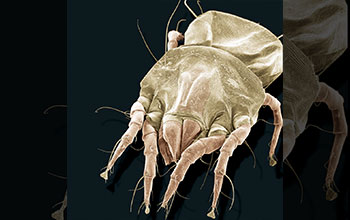Multimedia Gallery
Scanning electron microscope image of American house dust mite
A scanning electron microscope image of an American house dust mite (Dermatophagoides farina).
More about this image
House dust mites are tiny, free-living animals that evolved from a parasitic ancestor, which in turn evolved from free-living organisms millions of years ago.
A collaborative study involving researchers from the University of Southern Mississippi and a University of Michigan (U-M) biologist suggests that a consequence of this evolutionary history is that the house dust mite developed a novel way to protect its genome from internal disruptions.
All animals and plants face a threat from transposable elements, pieces of non-coding DNA that can change their position in the genome, often causing mutations and disease. Organisms have evolved complex ways to watch for, target and silence transposable elements. In most animals, this surveillance mission is carried out by small RNA fragments that find and break offending genetic sequences. The mechanism is called the piwi-associated RNA pathway, named for the protein Piwi, first discovered in fruit flies.
For the study, the researchers sequenced the DNA and the RNA of the American house dust mite Dermatophagoides farina. Then they looked at the populations of small RNA molecules encoded there.
They discovered that house dust mites do not have Piwi proteins or the associated small RNAs that most animals use to control transposable elements. Instead, dust mites have replaced the Piwi pathway with a completely different small RNA mechanism that uses small-interfering RNAs. The dust mite genome also encodes a protein that can amplify small-interfering RNAs.
"We believe that the evolution of this novel mechanism to protect genomes from transposable elements is linked to the unusual evolution of the dust mite," said Pavel Klimov, an associate research scientist in the U-M Department of Ecology and Evolutionary Biology and a co-author of a published paper about the research. "These animals evolved from parasitic ancestors. Frequently, the transition to parasitism is associated with dramatic genetic changes, a legacy carried by the dust mite when it moved back to a free-living lifestyle."
The published paper reports the first, high-quality assembly of the genome of the house dust mite, Klimov said.
This research was supported by a grant from the U.S. National Science Foundation (grant MCB 1616725).
Learn more in the University of Michigan news story House dust mites evolved a new way to protect their genome. (Date image taken: 2000's; date originally posted to NSF Multimedia Gallery: April 13, 2018)
Credit: Ellen Foot Perkowski
Images and other media in the National Science Foundation Multimedia Gallery are available for use in print and electronic material by NSF employees, members of the media, university staff, teachers and the general public. All media in the gallery are intended for personal, educational and nonprofit/non-commercial use only.
Images credited to the National Science Foundation, a federal agency, are in the public domain. The images were created by employees of the United States Government as part of their official duties or prepared by contractors as "works for hire" for NSF. You may freely use NSF-credited images and, at your discretion, credit NSF with a "Courtesy: National Science Foundation" notation.
Additional information about general usage can be found in Conditions.
Also Available:
Download the high-resolution JPG version of the image. (1.6 MB)
Use your mouse to right-click (Mac users may need to Ctrl-click) the link above and choose the option that will save the file or target to your computer.

 All images in this series
All images in this series